This post is also available in: Dansk
All photos © Bente Steffensen & Uffe Damm Andersen.
Birdwatching on the famous Manu Road
In early April 2019, we spent eight days on the famous Manu Road in Peru. Some of you are undoubtedly raising your eyebrows thinking – “Manu Road?” But if you are a birder, you have probably heard of Manu Road – maybe you are dreaming of going or you have been there already.
Peru has a lot more to offer beside pisco sour, Inca culture and Machu Picchu. There are many birds, 1858 different species according to BirdLife International * – and many of them are endemic. That makes Peru the country with the second-highest number of bird species, second only to Colombia’s 1878 species according to BirdLife International **.
It is therefore not surprising that Peru is a popular destination for birding tourism.
So what is it about this road? What makes Manu Road famous is that if you take a trip along this road you could potentially see more than 1000 species of birds – and that is a lot!
Manu Road starts in the town of Paucartambo in the Andes approximately a three-hour drive from Cusco. The most interesting part of the around 170 km road starts where it meets Manu National Park which is one of the most biodiverse areas in the world. From here the road follows the national park’s southern perimeter. The next approximately 145 km passes through several ecosystems as it goes down the mountains to the Amazon lowlands. The great diversity of habitats means that there are many bird species.

However, it takes a lot of time, planning and local knowledge – and luck – if you are going to reach anywhere near the 1000 species.
For us the choice was easy – of course, we had to go birding on the famous Manu Road.
Advertisement
Three people and a large minibus
We were picked up in Cusco by Omar early in the morning. In addition to a large white minibus, with enough room for a small group of travelers, Omar also brought his own binoculars, field guide and recordings of birdcalls for playback!
It turned out that we had Omar and his minibus at our disposal all week – and that was a good thing. Omar had been a driver on many birding trips before and he knew where we could find many of the most exciting bird species.
Another plus was that we now had to speak Spanish all week – and we really needed to train our language skills.
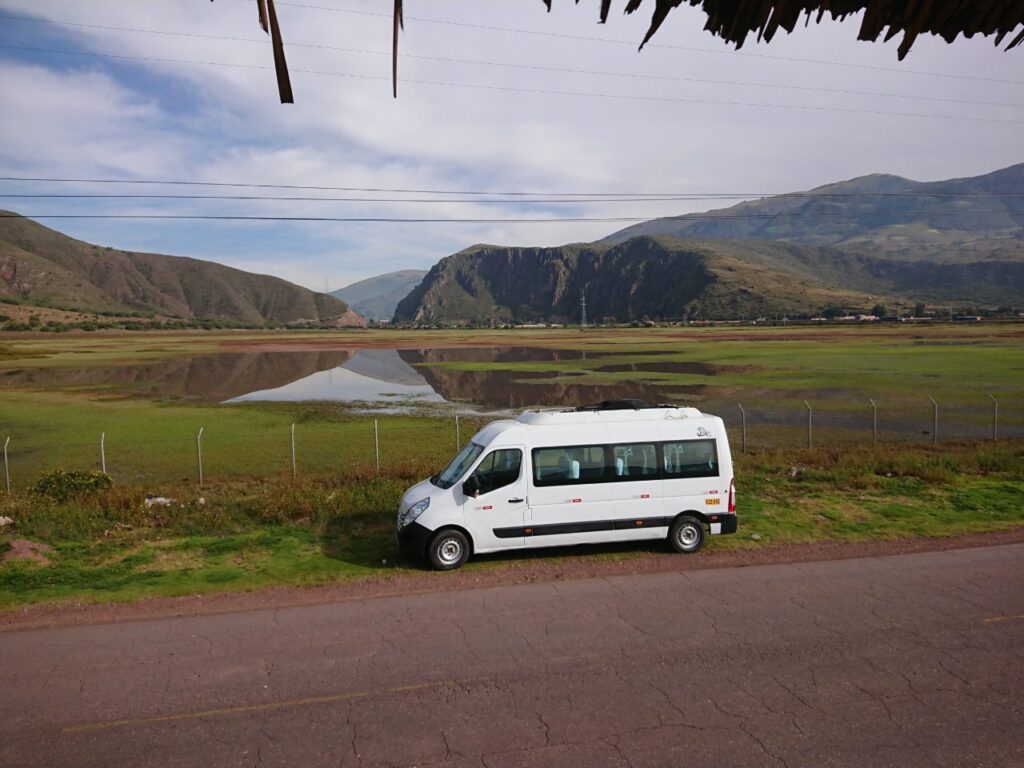
A transport day turned into a field day
What we first thought was just going to be a transport day – that is, one of those days that, regardless of the length of the trip, is just about moving from point A to point B – ended up being an excellent day in the field with new bird species being added to our list.
We visited the Laguna de Huarcapay wetland, located about 30 km southeast of Cusco at an altitude of approx. 3100 m. A site that can easily be visited en route to the famous Manu Road or as a day trip from Cusco.
The observation conditions are good and there is even a bird observation tower. From the tower, it is easy to observe different waterbirds on the water and in the wetland. In the reeds and the surrounding countryside, it was the more discreet birds and “difficult” birds that hid, among them the endemic Rusty-fronted Canastero Asthenes ottonis.
Along the way around the wetland, we saw Giant Hummingbird – which, with its 16 cm, is the world’s largest hummingbird. And then we must not forget the ever-present Rufous-collared Sparrow. We saw many more species, but the rest you can find on eBird.

We stopped at many other places along the way to look for interesting and fun species. In the mountains north of the town CP Huambutio, we added a few cool endemic species to our list: Creamy-crested Spinetail Cranioleuca albicapilla and Giant Chestnut-breasted Mountain-Finch Poospizopsis caesar.
Unfortunately, we did not manage to see the endemic hummingbird Bearded Mountaineer even though we tried several places
The sound of Hawaii
After a late lunch and a few hours of birding along the Manu Road, we arrived at Wayqecha where we were going to stay for a couple of nights.
The Conservacíon Amazónica (ACCA) organization owns and operates the Wayqecha Cloudforest Biological Station, located in the Kosnipata Valley at 3000 m above sea level. The field station reserve is a buffer along the southern border of Manu National Park and the field station is, therefore, a perfect starting point for exploring the birdlife in the cloud forest on the upper part of Manu Road.

However, one thing to keep in mind when staying at Wayqecha is that there is only power – and wifi – for three hours in the evening. So you have to be careful and keep the camera batteries well charged.
We were greeted and installed in a nice cabin, a little way from the main building, overlooking the valley and the forest. But there was a lot of fog so we looked out at a grey-white wall.
Back in the main building, we enjoyed a cup of hot tea before dinner. Suddenly we heard a sound outside, something that sounded like hooting. But it didn’t sound like an owl but more like a horn. Both mysterious and exotic – in fact, it sounded like someone blowing in a conch! But we were in a Peruvian cloud forest and not in Hawaii?
But that was exactly what it was. The chef had gone outside and blew in a conch, signaling that dinner was ready.
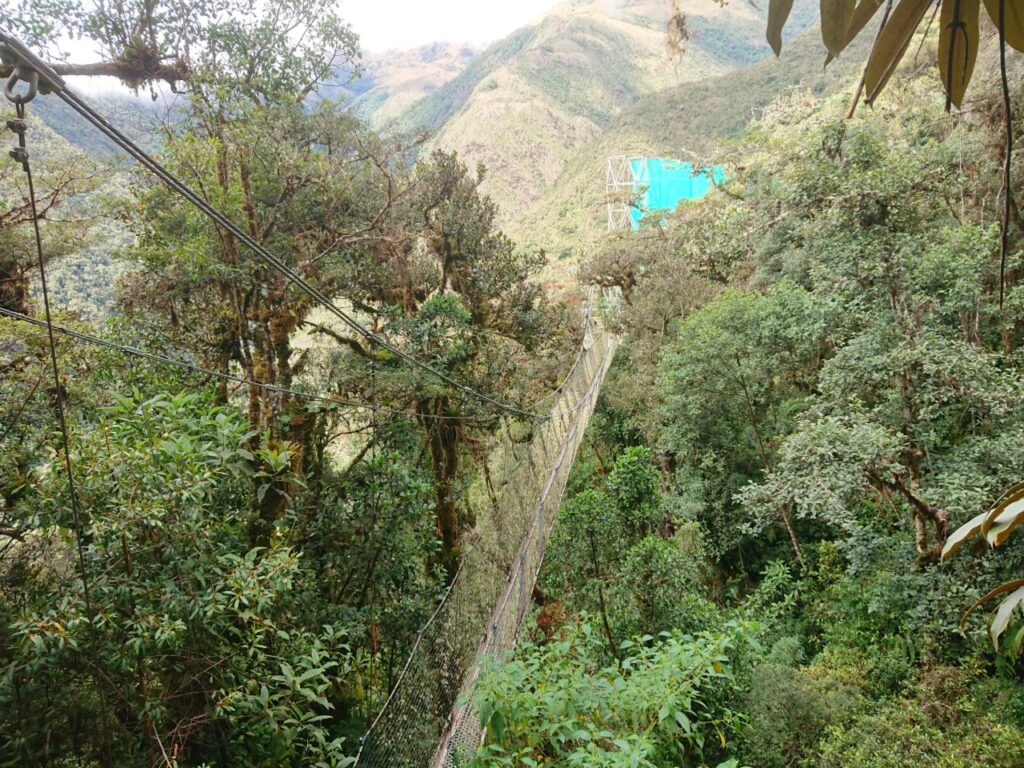
Waiting for the Antpitta
Cloud forest
We really enjoy the cloud forest! You can see some really exciting birds. It is also a really beautiful type of forest. The trees are crooked and low-stemmed. There are mosses, ferns, lichens and orchids and other epiphytes growing on the branches. The forest looks like something taken out of a fantasy movie – especially when it is foggy.
Seen through the eyes of a birder – conditions in a cloud forest can be a little challenging! The landscape is often shrouded in clouds and fog – a real pea soup. In other words, the birds can be hard to see.

The Antpitta
The endemic Red-and-white Antpitta is also difficult to see in good weather. It lives and stays well hidden on the forest floor.
At one point we heard one calling close by and we agreed to give it a try.
We left the road, crawled into the bushes and found a place where we hoped we could lure the antpitta towards us. But it is not enough to just sit in the bushes. That’s why we used playback – playing a recording of the species call – and hoped it would respond and come to us.

We sat quietly and listened. The antpitta came closer to where we sat huddled together in hopes of being invisible. We couldn’t see it, but judging by the sound it was very close – it was curious about who was “calling”.
Antpittas have an incredible ability to be virtually invisible even if you are only a few meters away. It had probably already seen us.
Omar lifted his arm very carefully and pointed. We couldn’t see anything. Omar gently moved his arm and now pointed a little farther to the right – and for a brief moment – a small egg-shaped red-brown bird jumped a few meters from us – a Red-and-white Antpitta!
See also Maria, Shakira and “The Antpitta Man” – on our experiences with Antpittas in Ecuador.
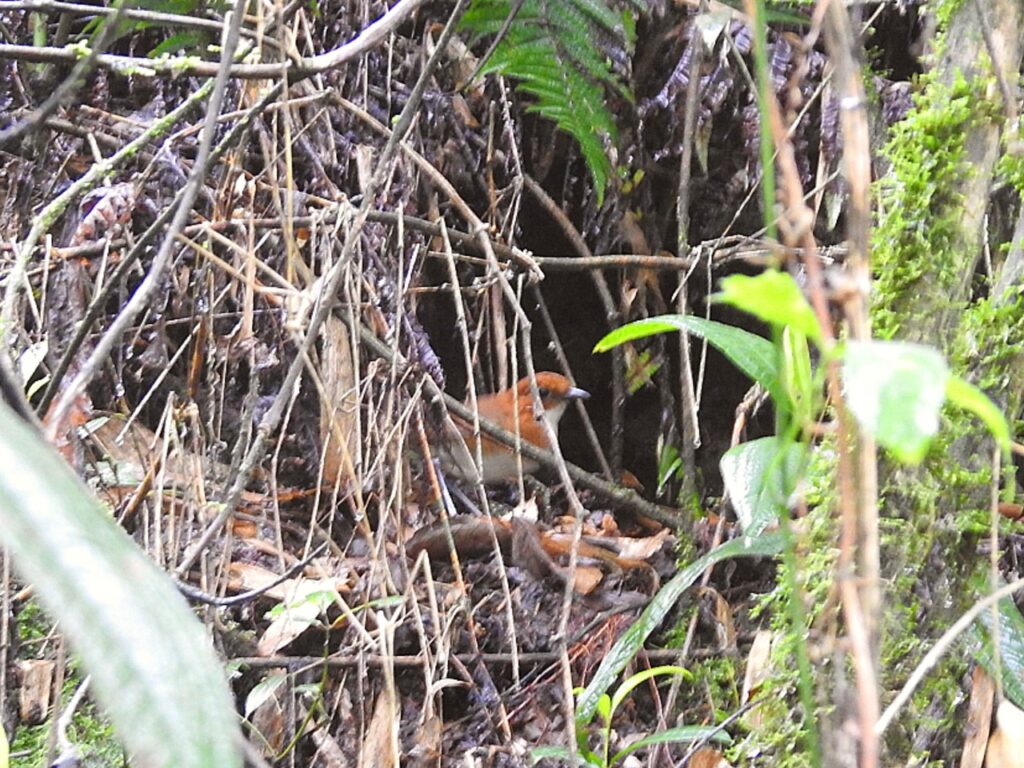
Parrots, Cotingas and Owls in the jungle
The field station in Amazonas
At the foot of the Andes, where the Amazon Plateau begins, Manu Road passes the town of Pillcopata. Just outside the town is Villa Carmen Biological Field Station, also owned and operated by ACCA, and we stayed here for four nights.
Villa Carmen is somewhat larger than Wayqecha and with significantly more luxurious conditions.
It was outside of the high season, which meant there weren’t as many tourists in the area. We were the only guests at Villa Carmen – so we had all the lavish luxury to ourselves!
We had come down into the lowlands of the Peruvian Amazon, and this was clear by both the heat and the high humidity – and not least by the birdlife, now we could see Amazona species.
The biodiversity is very high in the area, and there are many different habitats – not least bamboo forest, with some very interesting birds. There are “real” rainforests – i.e. rainforests with old trees – there are secondary forests, streams and rivers. There are also “low lying” mountain forests, as there are a few small mountains that reach 1200 m altitude
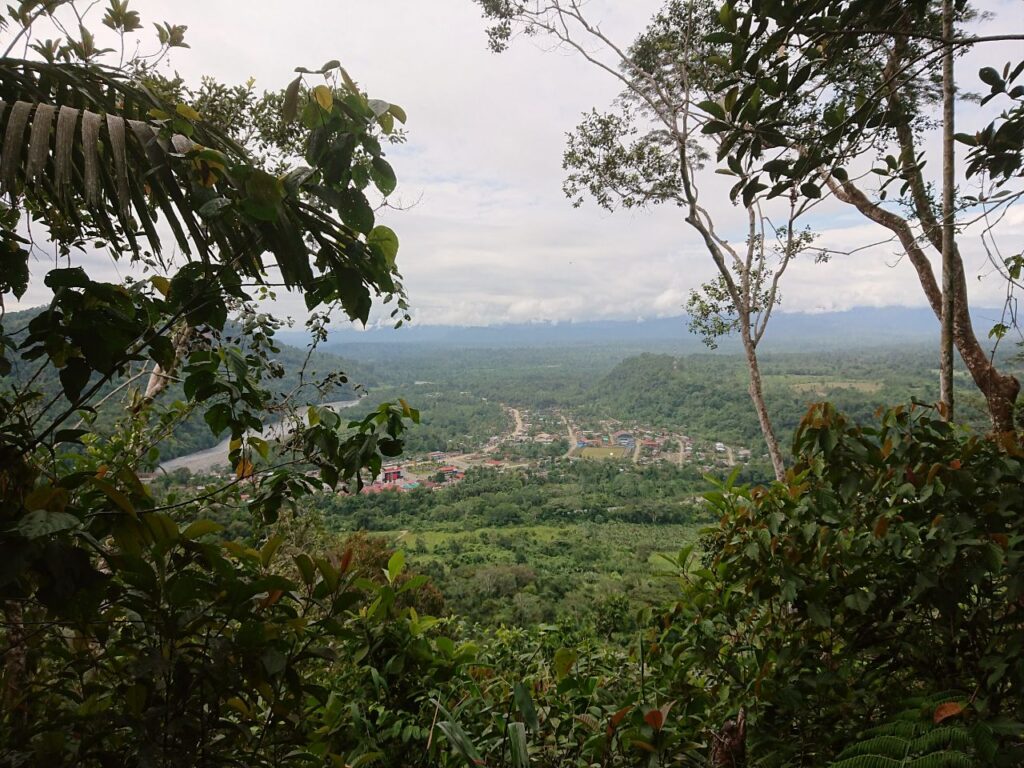
Villa Carmen is an excellent place to experience some of the varied nature and wildlife of the Amazon. The whole thing was literally on the doorstep. From our cabin, we could sit and enjoy herds of Hoatzins, parrots and hummingbirds. In the evening around sunset, we could hear the melancholy calls of at least three species of tinamous.
Birdlife around Villa Carmen
The days, of course, were spent watching birds on Manu Road. But we also spent a lot of time exploring the birdlife in the forest around Villa Carmen and there are many birds.
We saw the beautiful Plum-throated Cotinga several times, there were several species of parrots and macaws, often passing in droves above us. There were antbirds, antwrens and antshrikes. At the lodge’s main building, there were hummingbirds, like the little Rufous-crested Coquette.
Early one morning we were on a sweat-dripping four-hour bird walk with the field station’s young bird guide. Most of the time it went steeply upwards. And then, on the other hand, the way back we could slip and slide in the mud all the way down, I am not sure which was the hardest.
It wasn’t just during the day that we were active. A couple of evenings we went owling after dinner. We were looking for owls using headlamps and playback. We heard Tropical, Tawny-bellied Screech-Owl and Black-banded Owl every night, but we couldn’t see them.
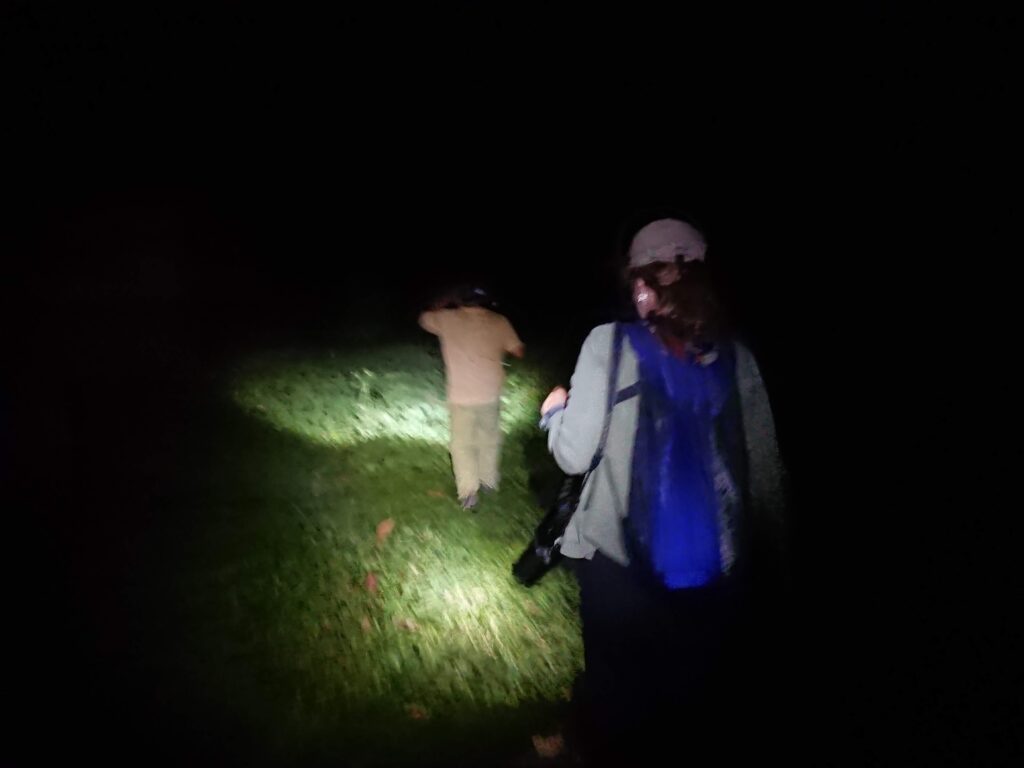
Flocks of mixed species
Birdwatching on the famous Manu Road is relatively easy. You “just” go down the road, stop at different places and look at birds from the road – and then you do the same on the way back. It is no wonder that the road is famous within the world of birding.
Along the road, there are several different lodges that each have their own particular species which may be difficult to see elsewhere. For example, Cock-of-the-Rock Lodge which we visited a few hours on the way back. Guess which bird you can see there.
Manu Road did not disappoint in any way – on the contrary. We didn’t get 1000 species, but we saw many birds and many different species, although we only birded part of the way.
We have never seen so many mixed species flocks and so many different types. There were small flocks, there were large flocks. Some flocks consisted of a few species and in other flocks there were 20-30 species.
It can be both fun and very hectic when encountering a mixed species flock. Often you only have a short time to identify the different species in the flock, sometimes the flock has passed in less than half a minute. Other times there is a tree with plenty of food for the birds, so you may be lucky that it takes several minutes before the flock moves on.
A mixed flock can cause neck pains as it often moves high up in the trees and the trees can be quite tall. In the higher elevations, Manu Road snakes down the hillsides, which means that we can often observe the flocks at eye level or even look down at them. It was much more comfortable.
Some of the birds
The eight days on the famous Manu Road yielded many birds and new species for our list. And here we finish the article by mentioning some of the species we saw. It is not the complete list.
Spectacled Whitestart Myioborus melanocephalus and the two beautiful tanagers Hooded and Scarlet-bellied Mountain Tanager were common in the cloud forest. A species that we saw many times was Black-faced Brushfinch Atlapetes melanolaemus.
Some species we only saw once, like Band-tailed FruiteaterPipreola intermedia, while we saw other species several times, such as the small toucan Blue-banded Toucanet.
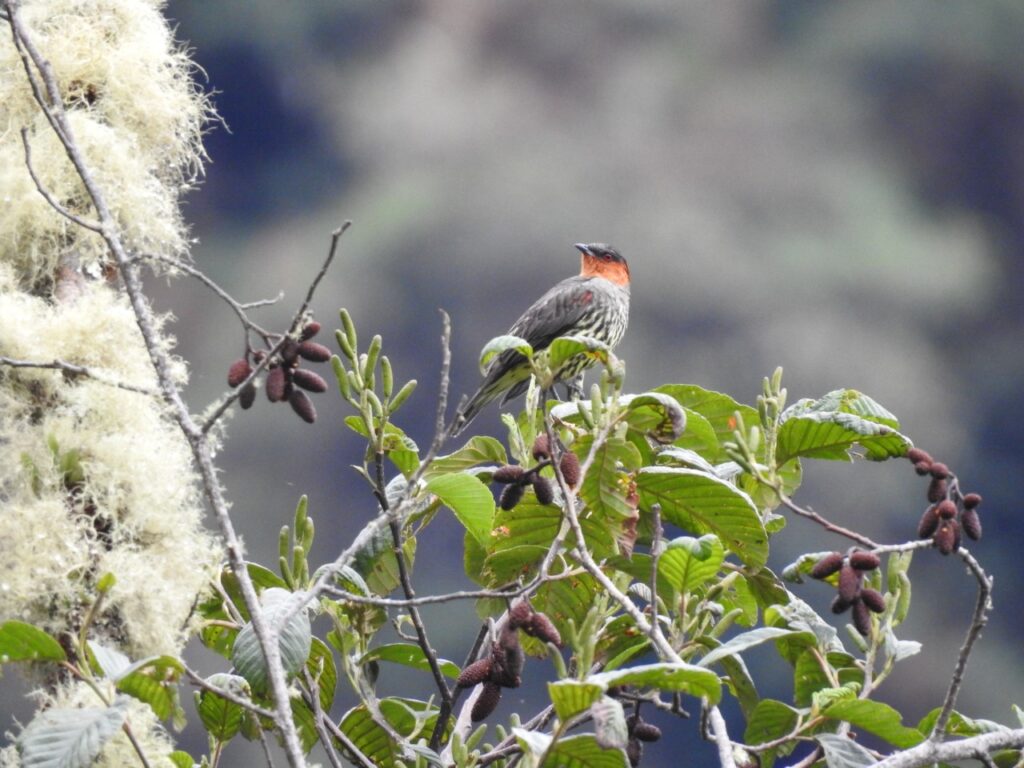
We also saw Montane Woodcreeper, Pearled Treerunner. There were Superciliaried Hemispingus and the endemic Parodi’s Hemispingus and finally we also saw Golden-collared Tanager. In the lower elevation between Weyquecha and Villa Carmen we saw herds of Golden-headed Quetzal and we were lucky enough to see Chestnut-crested Cotinga. At the well-known Cock-of-the-rock lek, we saw four Andean Cock-of-the-rock
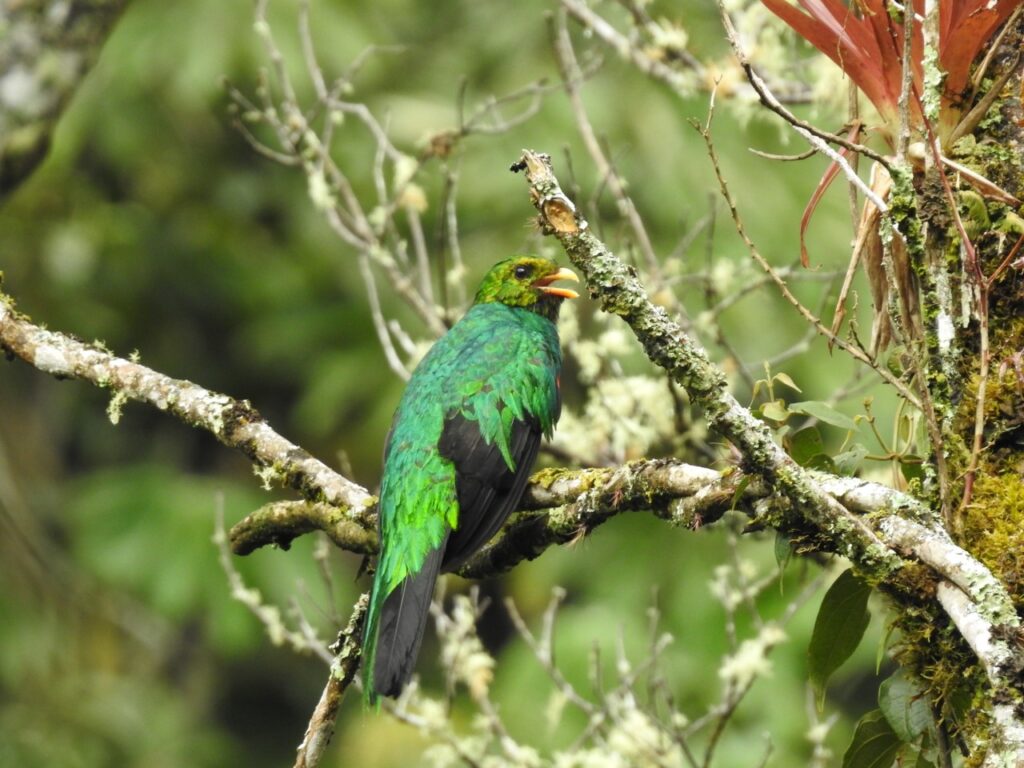
In the lowlands of the Amazon we saw Rufous-capped Nunlet, Red-throated Caracara. There where many parrots, amongst others Dusky-headed Parakeet, Blue-headed Pionus, Blue-and-yellow, Scarlet and Chestnut-fronted Macaw. There were Bamboo Antshrike, Stripe-chested Antwren, Yellow-breasted Warbling-Antbird, Manu Antbird, Goeldi’s Antbird and Black-spotted Bare-eye. There were tody-tyrants and tody-flycatcher and we saw many tanagers.
All photos © Bente Steffensen & Uffe Damm Andersen.
Advertisement
Sources
* BirdLife International (2019) Country profile: Peru. Available from http://www.birdlife.org/datazone/country/peru. Checked: 2019-09-03
**BirdLife International (2019) Country profile: Colombia. Available from http://www.birdlife.org/datazone/country/colombia. Checked: 2019-09-03

